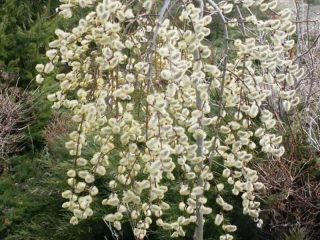Content
Ashy or gray willow (lat. Salix Cinerea) is a small densely branched shrub belonging to the Willow family. The plant requires minimal care and quickly adapts to almost any conditions, fitting perfectly into the landscape design of the garden.
Description of ashy willow with photo
Ash willow (Salix Cinerea) is a spreading, rounded shrub. The plant reaches a height of 3 to 5 m with a crown diameter of no more than 3 m. Its bark is dark gray in color. There are many long scars on the exposed wood.

Ash willow is called “black vine” because its shoots are densely covered with black hairs
Densely leafy branches of a dark gray hue are thick, but brittle. The flattened brown buds reach no more than 4 mm in length.
A distinctive feature of ash willow is its elongated leaf blades, covered on both sides with thin hairs and slightly pointed downwards. They are dark green above and gray felt below. The size of the leaves varies from 4 to 12 cm. They are located on short, pubescent petioles.
Ash willow is a honey plant. The plant blooms in mid-spring, before or during leaf bloom.The male catkins are ovoid in shape with two stamens, a single posterior nectary and yellow anthers, and can be quite thin. They reach no more than 2 cm in length. Women's earrings are up to 4 cm long and have the shape of a cylinder. Cone-shaped elongated ovary of a grayish tint.

Gray willow bears fruit in May, the fruits are capsules reaching a length of no more than 3 mm
Ash willow is a frost-resistant plant suitable for growing in northern regions. Only young plants need shelter for the winter. The moisture-loving shrub is not resistant to drought.
Ash willow is a light-loving plant. The shade of the leaves can be more saturated if the plant is provided with 6 hours of daylight. At the same time, the shrub will feel comfortable in partial shade.
Where does it grow
Gray willow grows naturally in Europe, Transcaucasia, Kazakhstan and Western Siberia. The plant can be found in mixed forests, marshy areas, floodplain meadows and near ditches.
Benefits and Applications
Almost all parts of the plant are used for domestic purposes. Ash willow leaves are used as feed for goats and sheep, branches are used for coarse weaving, and wood is used for making various household crafts.
A medicinal decoction is prepared based on the bark of the shrub, which has the following properties:
- antipyretic;
- wound healing;
- painkiller;
- diuretic;
- anthelmintic;
- anti-inflammatory.
In folk medicine, the decoction is used mainly in the treatment of diseases of the gastrointestinal tract, heart and joints.
Advantages and disadvantages
Ash willow (gray) is considered a fast-growing shrub. The annual growth averages 35-50 cm. A shrub growing near a reservoir begins to grow rapidly, forming dense stands.

The peak of decorativeness of ash willow occurs during flowering
Pros:
- ease of care;
- shade tolerance;
- possibility of use in farming and herbal medicine;
- frost resistance (up to -40 °C);
- undemanding to the type of soil;
- highly decorative;
- rarely attacked by harmful insects;
- resistance to waterlogging.
Minuses:
- branches break easily when exposed to strong winds;
- does not tolerate drought very well.
Features of cultivation
It is recommended to plant ash willow seedlings in the spring. The optimal dimensions of the planting hole are 50x50 cm, depth is at least 40 cm.
Ash willow will feel good in peat soil, black soil or loam, in close proximity to a reservoir. If you plan to plant the plant in sandy soil, then it is recommended to fill the planting holes halfway with a mixture consisting of the following components:
- black soil;
- compost;
- manure;
- humus.
All components must be taken in equal parts. Before filling the holes with the prepared mixture, it is recommended to lay a layer of drainage on the bottom. You can use pebbles, which will not allow the liquid to go deep into the soil.
In the first year after planting, you need to water the moisture-loving ash willow regularly, preventing the soil from drying out. Mulch, which can be dry grass clippings or fallen leaves, will help keep the soil moist.It is recommended to cover young shrubs with mulch material in the fall to protect their root system from the negative effects of low temperatures.
Ash willow, planted in fertile soil, does not need fertilizer. In other cases, it will be necessary to apply complex fertilizing twice a season.
Reproduction
Gray willow is propagated by seed or vegetative means. The first method is rarely used, because the seeds remain viable only for ten days.
The vegetative method is considered optimal, since green cuttings of ash willow take root well.

It is recommended to carry out cuttings in early spring
To begin with, cut branches at least 15 cm long must be placed in a solution of a growth stimulator (Epin, Kornevin, Zircon) for 2-3 hours. Then the cuttings should be buried in the soil by 1/3 of their length and watered abundantly.
Ash willow can also be propagated by grafting onto a standard, but this method is labor-intensive. It is only used by specialists with certain skills.
Application in garden landscape design
In landscape design, ash willow is used as a background plant in mixborders.

Shrubs are also used to create hedges
The plant goes well with conifers and shrubs, which have bright foliage. Ash willow looks picturesque in gardens decorated in Japanese or French style.

Gray willow can be used as a tapeworm in landscape design
Conclusion
Ash willow is a hardy, unpretentious shrub that requires only timely watering for full development. The plant tolerates pruning well, so the branches can be periodically shortened to give them a beautiful shape.








